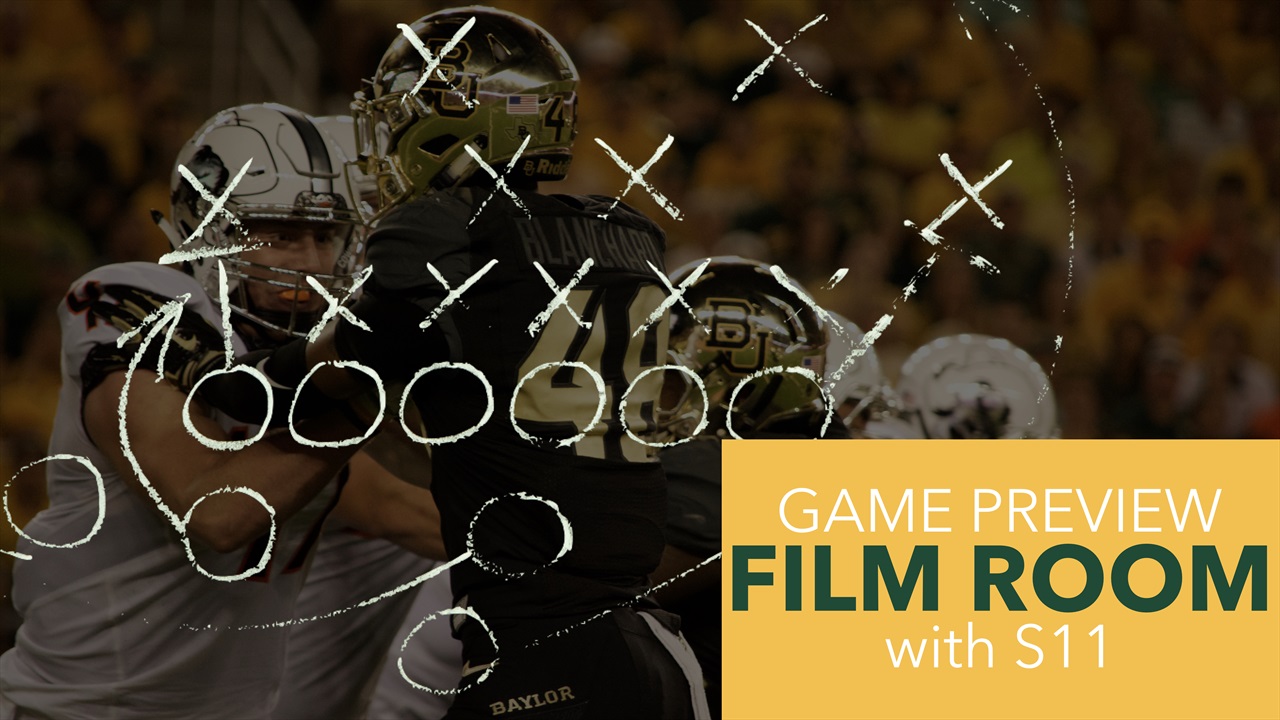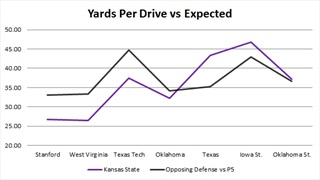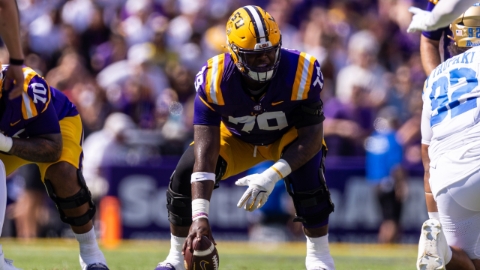
Baylor returns home for senior day and for the second year in a row will be going into the Kansas State game without an injured Seth Russell. Baylor's defense will be faced with a Kansas State offense that presents an unusual amount of schematic challenges to a defense. The Wildcats come to Waco with a modest 5-4 record that easily could be 8-1 had a couple close games broken another way. Head Coach Bill Snyder is among college football's best coaches and is underappreciated as a schematic innovator. Baylor will have it's hands full Saturday.
 SicEm365
SicEm365
The Wildcats run the ball 56% of the time and 5.48 per non-sack carry against power 5 opponents. They benefit a lot from involving their quarterback in their run schemes as their QB yards per non-sack carry is 6.27 and their non-qb's average 5.
Their yards per pass play (yards per attempt WITH sacks factored in) is 4.8 which is below any Big 12 opponent that the Bears have played this season. The Wildcats have given up a sack rate of over 7% and a TFL rate of over 10.8% which hints at some potential struggles up front.
Kansas State will line up in formations varying from one wide receiver, five receivers, and anything in between. They will line up with their tight ends, fullbacks, and receivers in different alignments. One play they line up like Texas Tech and the next it's like Stanford. This tests the defense to get lined up.
Snyder's KSU staff more than anyone else in the Big 12 wants to get their quarterback involved in the running game. Snyder has been running option plays in his offense dating back even before he had standouts like Michael Bishop, Ell Roberson, and Colin Klein. By using the QB as either a designed runner or by using option reads & pitches they account for a defender that handoffs typically don't. This makes the line's job easier and creates more room to run. Below are some clips that show how KSU has used their QB's to either carry the ball themselves or free up someone else. KSU does this to an extreme degree and their current QB's account for just under 40% of the total rushing attempts and yards by the Wildcat offense.
Like most teams KSU also features a competent passing game that features heavy input by former Houston and Wyoming head coach Dana Dimel who coached some very productive spread passing attacks in his career including experience with Sonny Dykes and the Air Raid at Arizona.
Additionally KSU alters their line splits (space between linemen) to situationally gain even more of an advantage for their linemen.
All of that on it's own is a solid task to defend but Kansas State has one more ace up their sleeve. The Wildcats make dramatic use of run/pass option plays. Their quarterbacks will often run towards the line patiently behind linemen who are 100% blocking for the run while they maintain the option to pass to receivers running routes downfield. Kansas State does a GREAT job on play design with this. The Wildcats find new ways to put linebackers and defensive backs in conflict between what their run responsibility is and who they need to cover in the passing game.
Basically every thing you can do to be schematically living on the edge- they do. Don't let Bill Snyder's stoic persona fool you- he is a dynamic innovator who is among the best ever to coach the game.
At tailback KSU relies on #24 Charles Jones (5-10, 208 lbs, Sr.) and #32 Justin Silmon (5-10, 198 lbs, So.) to spark their rushing attack. Jones is a well rounded and experienced player with experience taking direct snaps in their wildcat package in prior seasons. Silmon is a little more dynamic and explosive. The primary fullback and tight end for KSU are #38 Winston Dimel (6-1, 235 lbs, So.) and #88 Dayton Valentine (6-4, 264 lbs, So.) who are well rounded players who are capable both blocking and receiving. Dimel is also used as a tailback in certain sets and has 8 rushing touchdowns this season.
At receiver KSU's leading receiver is slot weapon #4 Dominique Heath (5-9, 175 lbs, So.) who has 39 catches for 406 yards. He's the kind of speedy and quick player you'd expect with his size and position. On the outside KSU features the reliable and experienced #6 Deante Burton (6-2, 209 lbs, Sr.) at one spot with 297 yards on 22 catches. The newcomer who has created some big plays for KSU is JC transfer #9 Byron Pringle (6-2, 205 lbs, So.) who has 275 yards so far.
KSU has clearly reshuffled things on the line. The Wildcats replaced four out of five starters up front and the lone returning starter changed positions. Two notable players are preseason All-Big 12 #71 Dalton Risner (6-5, 300 lbs, So.) and #67 Reid Najvar (6-4, 295 lbs, Jr.) who is the younger brother of former Baylor standout Jordan Najvar.
Baylor's relatively conservative coverage calls also left them outnumbered against Kansas State's running game. By not deploying their safeties aggressively they were able to protect against most big passing plays but the trade off was giving KSU consistent running lanes on the ground, particularly with how much they involve the QB to gain an even bigger edge.
OFFENSIVE STATISTICS
In terms of yards per drive, KSU is fairly average in that they have generated roughly 96% of the yards that other P5 competition has against their power conference opponents. Games against Texas, ISU, and OSU were better than average while Stanford, WV, Oklahoma, and Texas Tech were below what other teams accumulated. SicEm365
SicEm365
The Wildcats run the ball 56% of the time and 5.48 per non-sack carry against power 5 opponents. They benefit a lot from involving their quarterback in their run schemes as their QB yards per non-sack carry is 6.27 and their non-qb's average 5.
Their yards per pass play (yards per attempt WITH sacks factored in) is 4.8 which is below any Big 12 opponent that the Bears have played this season. The Wildcats have given up a sack rate of over 7% and a TFL rate of over 10.8% which hints at some potential struggles up front.
OFFENSIVE SCHEME
Kansas State's offense is every Big 12 opponent's annual calculus exam. Like McGuyver they incorporate anything and everything to get the job done to the point I am honestly surprised that they don't have duct tape as part of the uniform. I mean this in the most complimentary way possible as Snyder and OC Dana Dimel have created a very big equalizer of an offensive scheme that annually gives opponents heartburn without elite recruting rankings.Kansas State will line up in formations varying from one wide receiver, five receivers, and anything in between. They will line up with their tight ends, fullbacks, and receivers in different alignments. One play they line up like Texas Tech and the next it's like Stanford. This tests the defense to get lined up.
Snyder's KSU staff more than anyone else in the Big 12 wants to get their quarterback involved in the running game. Snyder has been running option plays in his offense dating back even before he had standouts like Michael Bishop, Ell Roberson, and Colin Klein. By using the QB as either a designed runner or by using option reads & pitches they account for a defender that handoffs typically don't. This makes the line's job easier and creates more room to run. Below are some clips that show how KSU has used their QB's to either carry the ball themselves or free up someone else. KSU does this to an extreme degree and their current QB's account for just under 40% of the total rushing attempts and yards by the Wildcat offense.
Like most teams KSU also features a competent passing game that features heavy input by former Houston and Wyoming head coach Dana Dimel who coached some very productive spread passing attacks in his career including experience with Sonny Dykes and the Air Raid at Arizona.
Additionally KSU alters their line splits (space between linemen) to situationally gain even more of an advantage for their linemen.
All of that on it's own is a solid task to defend but Kansas State has one more ace up their sleeve. The Wildcats make dramatic use of run/pass option plays. Their quarterbacks will often run towards the line patiently behind linemen who are 100% blocking for the run while they maintain the option to pass to receivers running routes downfield. Kansas State does a GREAT job on play design with this. The Wildcats find new ways to put linebackers and defensive backs in conflict between what their run responsibility is and who they need to cover in the passing game.
Basically every thing you can do to be schematically living on the edge- they do. Don't let Bill Snyder's stoic persona fool you- he is a dynamic innovator who is among the best ever to coach the game.
PERSONNEL
Kansas State had some of the worst injury luck at quarterback last year. This season they got #16 Jesse Ertz (6-3, 212 lbs, Jr.) back from injury and he's been the starter the entire year. He's a capable runner, fairly accurate passer, and features a solid arm. He completes 57% of his passes, has thrown for 1165 yards, and has 630 yards rushing. His backup is last year's starter #8 Joe Hubener (6-5, 212 lbs, Sr.) who is a tough runner but can struggle with accuracy from time to time.At tailback KSU relies on #24 Charles Jones (5-10, 208 lbs, Sr.) and #32 Justin Silmon (5-10, 198 lbs, So.) to spark their rushing attack. Jones is a well rounded and experienced player with experience taking direct snaps in their wildcat package in prior seasons. Silmon is a little more dynamic and explosive. The primary fullback and tight end for KSU are #38 Winston Dimel (6-1, 235 lbs, So.) and #88 Dayton Valentine (6-4, 264 lbs, So.) who are well rounded players who are capable both blocking and receiving. Dimel is also used as a tailback in certain sets and has 8 rushing touchdowns this season.
At receiver KSU's leading receiver is slot weapon #4 Dominique Heath (5-9, 175 lbs, So.) who has 39 catches for 406 yards. He's the kind of speedy and quick player you'd expect with his size and position. On the outside KSU features the reliable and experienced #6 Deante Burton (6-2, 209 lbs, Sr.) at one spot with 297 yards on 22 catches. The newcomer who has created some big plays for KSU is JC transfer #9 Byron Pringle (6-2, 205 lbs, So.) who has 275 yards so far.
KSU has clearly reshuffled things on the line. The Wildcats replaced four out of five starters up front and the lone returning starter changed positions. Two notable players are preseason All-Big 12 #71 Dalton Risner (6-5, 300 lbs, So.) and #67 Reid Najvar (6-4, 295 lbs, Jr.) who is the younger brother of former Baylor standout Jordan Najvar.
OFFENSIVE QUESTIONS
KSU was able to run extensively on Baylor last season and the Bears allowed KSU the most yards per drive of ANY power conference opponent that KSU faced in 2015. What happened?
Baylor's defensive scheme tried to utilize their base match quarters coverages where the safeties and linebackers help each other cover interior receivers, the safeties have deeper responsibility and the linebackers have underneath. When the Wildcats used run/pass options they were able to exploit this by placing the underneath defenders in conflict. If they crashed against the run the safeties were too deep to deny the ball. If they dropped back the QB would have a wide open lane to run through.Baylor's relatively conservative coverage calls also left them outnumbered against Kansas State's running game. By not deploying their safeties aggressively they were able to protect against most big passing plays but the trade off was giving KSU consistent running lanes on the ground, particularly with how much they involve the QB to gain an even bigger edge.
What could Baylor have done to limit this?
This isn't something that is an every down solution but crowding the line aggressively and forcing KSU's passing game to beat you is something that worked when it was tried last season. However this was not tried very often and KSU has a more accurate passer this season along with a better receiving corps.How did Baylor perform defensively against Oklahoma compared to how they performed against TCU?
Baylor didn't put up anything legendary in Norman, but after starting off very poorly was able to hold Oklahoma reasonably well after that. Holding the Big 12's best offense below their typical yardage per drive against P5 teams was a welcome sight after showing nothing against a less than stellar TCU offense the week before. Baylor held OU to 12 fewer yards per drive than they did TCU. TCU's non-qb's ran for 7.5 per carry with consistent success. OU had two carries from their tailbacks for 88 yards but the other 38 averaged 3.89. Last week was not any objectively strong game, but to say there wasn't a distinct step forward would be incorrect given how much better OU's offense is compared to TCU's.Never miss the latest news from SicEm365!
Join our free email list



